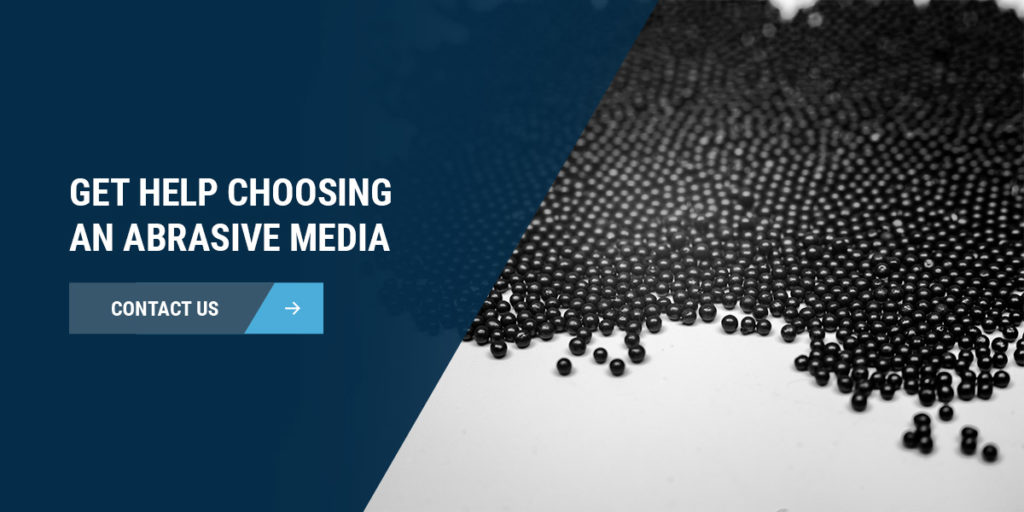How to Choose an Abrasive Media
March 07, 2023Abrasive media blasting is an efficient, safe and cost-effective process when working with metal substrates. It enables you to clean the surface by removing materials and contaminants, which prepares it for painting, powder coating and other finishing techniques. You can also use blasting to remove previously applied coatings.
The blasting technique entails propelling abrasive materials onto the workpiece’s surface using a high-pressure stream of water. Depending on the type of metal you’re working with and the desired outcome, you can select from various media to complete the process. Examples include sand, aluminum oxide, glass beads, silicon carbide, corn cobs and walnut shells.
What to Consider When Choosing Abrasive Media for Your Project
Knowing what abrasives are available is the first step in choosing the right one for your project. However, you also need to understand the demands of your project and how the characteristics of an abrasive will support those demands. Consider the following factors.
Mohs Hardness
The hardness of minerals is defined by the Mohs hardness scale. Abrasive media like silicon carbide has a high hardness value, while a plastic abrasive has a much lower hardness. The softer your abrasive is, the finer your finish will be. Harder abrasives are best for tougher jobs, like removing rust and corrosion.
Shape and Tread
Abrasives come in different shapes that affect how much of the material comes in contact with your surface. Angular and sub-angular abrasives like crushed glass and plastic urea have jagged edges and angular shapes. These types have less contact with your surface but have a more aggressive cutting ability.
Sub-rounded and rounded abrasives are mostly or completely smooth, like walnut shells and glass beads. These abrasives are far less aggressive in their cutting ability but easily create a refined scratch pattern.
Density
Density relates to how tightly the atoms of a substance are packed together. High-density abrasives have more impact on a small area and create deep profiles on your surface. If you want less force, you need a less dense material. For example, steel shot has a relatively high density, and walnut shell has a low density.
Coating Requirements
Coatings have depth profile requirements to ensure optimal bonding. Make sure your abrasive can create the appropriate peaks and valleys in your surface before coating. Consider size and shape when making this consideration.
Use of Machinery
Abrasives will only perform their best when you use your machine correctly. For example, lower grit abrasives work best with a lower RPM. If you run an abrasive at a higher speed when it has a lower grit, you may experience resin transfer.
Frequently Asked Questions When Choosing an Abrasive Media
Use the answers to these frequently asked abrasive media questions to help you make an informed choice for your projects.
Can You Reuse Sandblasting Media?
Whether you can reuse or recycle your abrasive media depends on several factors. If you use a blast cabinet to perform the process, you can reuse the material multiple times. While you can’t reuse materials such as sand, glass beads and steel shot, you can give them a second life by recycling them. However, you can’t recycle any media used in portable blasting applications with no containment method.
Should I Choose Single-Pass or Multiuse Media?
A material’s Mohs Hardness Scale rating can help determine whether you can use it once or multiple times. A higher ranking means the media is harder, enabling you to use it repeatedly. Conversely, a low-rated material may break down after a single use — the remaining particles are too small for recycling or reuse.
Single-use media can be more cost-effective for one-off projects. A multiuse product can provide better long-term value if you need it for several surface preparation jobs.
How Long Does Blasting Media Last?
The size and composition of the material will impact its longevity — a larger, harder material offers more potential for extensive reuse. Using a separator with your blasting cabinet will prevent contamination that could limit the abrasive’s life span. Blasting below the material’s maximum impact velocity can also result in longer product life.
Get Help Choosing an Abrasive Media
As you can see, there are many factors to consider when choosing abrasive media for your applications. Finishing Systems has the experience and expertise to help you make the best decisions for your business’s surface preparation projects. Contact us to learn more about our abrasives and related services today.

